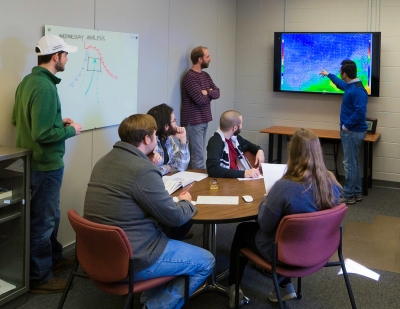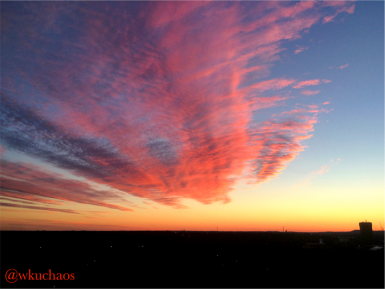WKU News
WKU adds CHAOS weather observation, forecast facility
- Tuesday, April 7th, 2015
The Hill has seen its fair share of extreme weather and climate events over the years, including floods, crippling ice storms, paralyzing snows, damaging hail and wind, heat and cold spells, and tornadoes.

Dr. Josh Durkee and WKU meteorology students at work in the CHAOS (College Heights Atmospheric Observatory for Students) facility.
Now with the addition of the College Heights Atmospheric Observatory for Students (CHAOS), WKU has fresh eyes to monitor these hazardous conditions that pose a potential threat to the faculty, staff and more than 21,000 students that work, live and travel to and from our campuses on a daily basis.
The first weather observations for this area began under the direction of Dr. Judson R. Griffin on March 1, 1932, with the College Heights Weather Station. Since that time, official weather observations have expanded to the Bowling Green-Warren County Regional Airport and other nearby off-campus areas with the use of automated observation stations, which are maintained by the National Oceanic Atmospheric Administration and the Kentucky Mesonet. In 2008, Dr. Michael Trapasso retired the College Heights Weather Station and converted the space in the Environmental Science and Technology (EST) building to an antique weather instrument museum.
Ironically, in the same year that the College Heights Weather Station closed at WKU, the Department of Geography and Geology launched a B.S. Meteorology Program. Now, in 2015, the program has grown to lead the department with nearly 35 percent of the total enrolled majors. The Meteorology Program primarily focuses on theory and applied learning through various forecasting and professional research activities. In 2014, Dr. Josh Durkee envisioned bringing back weather monitoring to WKU, but this time as a student-engagement endeavor that provides real-time weather observations specifically for the campus community during hazardous weather conditions.
“WKU has a rich tradition of collecting and reporting weather data from the Hill. I wanted to keep that tradition alive by updating the technology and involving students to help collect weather observations and participate in various learning activities that come along with analyzing the data,” Dr. Durkee said.
In keeping with the 86-year tradition of observing weather on the Hill, Dr. Durkee has reopened and expanded the space in EST and now serves as Director of the College Heights Atmospheric Observatory for Students, or CHAOS.
“CHAOS is a student-centered interactive atmospheric/geoscience learning, application, monitoring, prediction, and research facility that provides in- and out-of-classroom enhanced training for future meteorologists and climate scientists,” Dr. Durkee said.
In addition to students in the Meteorology Program, the CHAOS facility is utilized as an introductory learning space for the entire curriculum. The department projects that more than 500 students (mostly non-majors) will pass through this meteorology laboratory during the 2015-16 academic year to learn about the fundamentals of atmospheric science.
Technology plays a key role in contemporary training activities within CHAOS. The CHAOS Meteorology Laboratory consists of 23 custom-imaged computers outfitted with the latest professional weather analysis software. The CHAOS Forecast Laboratory consists of an automated weather station, a 360-degree horizon-view HD video camera (located on top of Van Meter Hall), a quad-copter with HD capabilities, a suite of computing hardware and software for tracking current and predicted weather and climate conditions, a NOAAPORT communications satellite, and an observation deck that overlooks the west-south-east horizon.
CHAOS adds a significant piece to the meteorology learning infrastructure at WKU. The Meteorology Program also hosts a severe weather spotter group known as the Storm Topper Network, which reports real-time observations to local emergency managers and the National Weather Service (NWS) in Louisville. Both CHAOS and the Storm Topper Network are partnered with Landon Hampton, a WKU Meteorology Program alumnus who started the local weather firm, WxOrNot. Together, these groups work closely to disseminate the most up-to-date weather information to the public, emergency managers and the NWS.
“The Meteorology Program at WKU is the wheelhouse for atmospheric science education, experience, and outreach for the university, the city of Bowling Green, and the surrounding region,” Dr. Durkee said. “The overarching goal for CHAOS is to provide an avenue for students to gain hands-on experiences with weather data analysis, observation, forecasting, and communication, with the coupled mission of striving to help protect life and property during hazardous conditions.”
“WKU leads the region in the development of learning and application strategies to train students for 21st century climate analysis and interpretation,” noted Geography and Geology Department Head Dr. David Keeling. “The goals of Dr. Durkee and his faculty/student team are to embrace the ‘evidence and argument’ approach (otherwise known as the Scientific Method) promoted by WKU’s Quality Enhancement Program to engage students in all aspects of climate analysis, research and communication for the wider benefit of our communities.”
![chaos logo [lightning]](https://wkunews.files.wordpress.com/2015/04/chaos-logo-lightning.png?w=150&h=137) The near-future plans for CHAOS include developing an interactive website and mobile app that hosts real-time webcam footage and weather data for WKU. In the meantime, you can follow CHAOS reports on Twitter at https://twitter.com/wkuCHAOS.
The near-future plans for CHAOS include developing an interactive website and mobile app that hosts real-time webcam footage and weather data for WKU. In the meantime, you can follow CHAOS reports on Twitter at https://twitter.com/wkuCHAOS.
The program is spearheaded by meteorology and climate science faculty, Dr. Rezaul Mahmood, Dr. Gregory Goodrich, Dr. Josh Durkee and Dr. Xingang Fan, along with Dr. Stuart Foster, the Kentucky State Climatologist. For more on the WKU Meteorology Program, visit http://www.wku.edu/meteorology/.
Contact: Josh Durkee, (270) 745-8777






